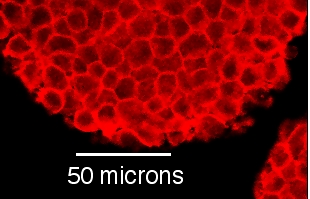细胞生物学/导论/细胞大小
外观

虽然一般来说,生物细胞太小,在没有显微镜的情况下根本无法看到,但也有一些例外,而且各种细胞类型的大小范围很大。 真核细胞 通常是 原核细胞 的 10 倍大(这些细胞类型将在下一章讨论)。 植物细胞平均来说是最大的细胞,这可能是因为许多植物细胞的内部大部分是充满水的液泡。
所以,你问,生物分子和细胞的相对大小是多少?以下都是近似值。
0.1 nm (nanometer) diameter of a hydrogen atom
0.8 nm Amino Acid
2 nm Diameter of a DNA Alpha helix
4 nm Globular Protein
6 nm microfilaments
7 nm thickness cell membranes
20 nm Ribosome
25 nm Microtubule
30 nm Small virus (Picornaviruses)
30 nm Rhinoviruses
50 nm Nuclear pore
100 nm HIV
120 nm Large virus (Orthomyxoviruses, includes influenza virus)
150-250 nm Very large virus (Rhabdoviruses, Paramyxoviruses)
150-250 nm small bacteria such as Mycoplasma
200 nm Centriole
200 nm (200 to 500 nm) Lysosomes
200 nm (200 to 500 nm) Peroxisomes
800 nm giant virus Mimivirus
1 µm (micrometer)
(1 - 10 µm) the general sizes for Prokaryotes
1 µm Diameter of human nerve cell process
2 µm E.coli - a bacterium
3 µm Mitochondrion
5 µm length of chloroplast
6 µm (3 - 10 micrometers) the Nucleus
9 µm Human red blood cell
10 µm
(10 - 30 µm) Most Eukaryotic animal cells
(10 - 100 µm) Most Eukaryotic plant cells
90 µm small Amoeba
120 µm Human Egg
up to 160 µm Megakaryocyte
up to 500 µm giant bacterium Thiomargarita
up to 800 µm large Amoeba
1 mm (1 millimeter, 1/10th cm)
1 mm Diameter of the squid giant nerve cell
up to 40mm Diameter of giant amoeba Gromia Sphaerica
120 mm Diameter of an ostrich egg (a dinosaur egg was much larger)
3 meters Length of a nerve cell of giraffe's neck
什么限制了细胞的大小?
- 原核生物 - 受限于有效的代谢
- 动物细胞(真核生物) - 受限于表面积与体积比
- 植物细胞(真核生物) - 由于大的中央液泡而具有很大的尺寸,液泡负责它们的生长
- 早期历史与对细胞存在和重要性的理解发展相关。 显微镜的重要性。
